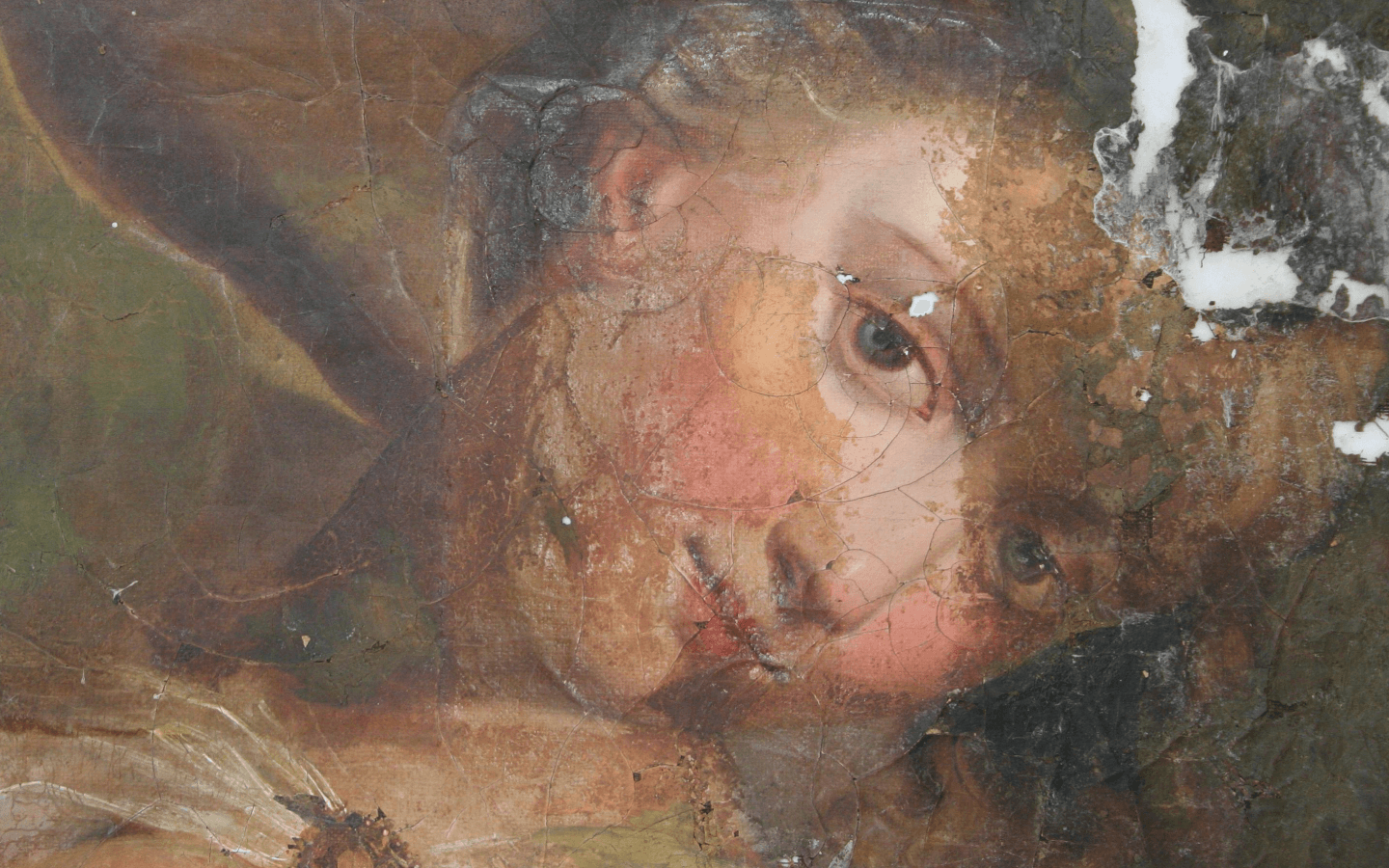Painting of St. Sunday on the south wall of the church of St. Elizabeth in Podrebra near Polhov Gradec.
Text by mag. Anita Kavčič Klančar from the Department of Wall Paintings and Mosaics, ZVKDS Restoration Centre


In the summers of 2023 and 2024, the Department of Wall Paintings and Mosaics conserved and restored the painting of St. Sunday on the south wall of the Church of St. Elizabeth in Podrebro near Polhov Gradec. The Gothic painting from the first half of the 16th century was discovered and conserved and restored for the first time as early as 1966, when a protective roof was also put over it.
Despite partial protection, the fresco has visibly deteriorated since its discovery. Exposure to sun, rain, wind and frost, excessive capillary humidity and inadequate artificial hardener from past interventions have contributed to its accelerated degradation. The paint layer had fallen off evenly over the entire surface, the scenes were no longer recognisable, only traces and faint outlines were visible. The existing paint layer was being erased and heavily dusted due to the loss of bonding. The lime plaster was also deteriorated and degraded, starting to crumble and fall away in the lower, most exposed part, with small cracks appearing in places.
The painting depicts an eschatological representation of the Suffering Christ, typical of the Middle Ages (Imago pietatis), around which are a series of genre scenes from everyday life, which the people insult Christ by doing on Sundays. Sunday, as the Lord's Day, also symbolically represents the Last Judgement, and thus directs the viewer to think about the last things. Alongside the central large life-size figure of Christ, we see smaller figurative scenes: a man chopping wood, another warming himself by the fire and drying his shoes, followed by horses, brass players and dancers, a shopkeeper and a merchant, scenes of lovemaking in nature, horse shoeing, fruit picking, bread baking, quartans, etc., and, at the very end, at the bottom right, a scene of hell with a cauldron in which the lost are being cooked. The Podrebrč painting is an interesting and rare example of ethnological, religious and art-historical heritage, and can be compared iconographically with the better-known painting of St Sunday on the façade of the Crngrob Church. From a technological point of view, it is a typical example of exterior paintings that have literally disappeared before our eyes in recent decades. We have therefore decided to consolidate and conserve it in a first phase (2023), and in a second phase (2024) to reintegrate the damage aesthetically. The colour and black-and-white photographs of the paintings discovered in 1966 were a great help in carrying out the conservation and restoration work, as the motifs and scenes in them were still very clearly visible.
The scene of the woman looking in the mirror, the devil and the woman pouring wine. Top left: black and white photo at the time of the discovery in 1966, INDOK archive, top right: colour photo at the time of the discovery in 1966, INDOK archive, bottom left: before the intervention in 2022, bottom right: after the intervention in 2024, photo by Anita Kavčič Klančar
Pre-curing of the dusty paint layer, cleaning and removal of unsuitable hardener, hardening of the plaster and paint layer were carried out with compatible inorganic materials (nanorestore, ammonium carbonate, barium hydroxide, etc.), which are related to lime in composition and ageing method. Due to the carbonatisation (drying) process, we waited about one month between each treatment. After curing, we started to putty and grout the damaged and detached parts of the plaster. The old 1966 seals were retained due to their strength and solid condition. We removed the remnants of the whitewash that remained on the paint layer after the first restoration. The entire painting was retouched with glaze dots, in a slightly lighter tone than the original. The retouch was carried out with great restraint and care, taking into account the degree of degradation of the painting. This type of retouching is about visually removing the damage from the field of vision. In doing so, the viewer's eye connects the previously damaged forms into a meaningful whole.
Restoration is seen as a kind of translation of the artwork into the modern age. We need to make art legible, but we also need to preserve its distinctive values and relationships: imagery, colour tones, technological execution, ageing, contextual and stylistic characteristics, narrative, ways of thinking, seeing and believing... Restoration is therefore about delving into all these characteristics and then preserving them in a multilayered way. Many a passer-by would like to see the fresco 'repaired' to a greater extent, added to or even repainted, but in doing so we would lose or override its very essence: its quirkiness, its narrative, its religious symbolism, its ethnological vividness, its vernacularity, its simplicity of colour and, last but not least, its venerable age. The planned installation of an information board with photographs of the paintings at the time of their discovery and descriptions of the scenes will fill this gap and at the same time help to improve the viewer's understanding of this fascinating medieval work of art.
The scene of hell
Before and after interventions


Project Manager: Janez Kosel, Ph. D. Mag. Anita Kavčič Klančar
Project collaborators: Jerneja Kos, Mojca Kos, Katarina Bartolj









